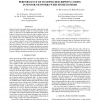Free Online Productivity Tools
i2Speak
i2Symbol
i2OCR
iTex2Img
iWeb2Print
iWeb2Shot
i2Type
iPdf2Split
iPdf2Merge
i2Bopomofo
i2Arabic
i2Style
i2Image
i2PDF
iLatex2Rtf
Sci2ools
ICMCS
2005
IEEE
2005
IEEE
Performance of Multiple Description Coding in Sensor Networks with Finite Buffers
Sensor networks are usually dense networks where the network diversity can be exploited in order to overcome failures. In this paper, we study the use of multiple description techniques in the context of sensor networks where the cause of failures is due to the usual practical constraint of having finite buffers in the sensors, instead of the more traditional case of link failures considered in previous research. Although from a theoretical point of view we observe that the use of more descriptions provides usually better performance, we show experimentally that this is not the case in practice, when real constraints are introduced, such as finite buffers and the presence of header information, necessary for any real application. Our main result is that the optimal number of descriptions, in terms of average distortion, decreases as the fraction of header information increases for a given buffer size.
| Added | 25 Jun 2010 |
| Updated | 25 Jun 2010 |
| Type | Conference |
| Year | 2005 |
| Where | ICMCS |
| Authors | Enrico Baccaglini, Guillermo Barrenetxea, Baltasar Beferull-Lozano |
Comments (0)

